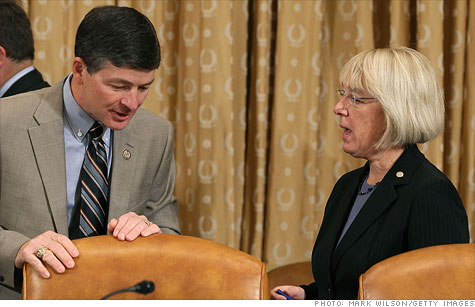
Rep. Jeb Hensarling and Sen. Patty Murray, the Republican and Democratic co-chairs of the Congressional debt committee, confer at the group's hearing Tuesday.
NEW YORK (CNNMoney) -- Washington's latest parlor game is placing odds on a) whether the congressional debt committee will be able to agree on anything and b) if so, what?
Republicans still appear resistant to taxes as a significant deficit-reduction measure. And Democrats remain resistant to any plan that lacks a meaningful tax component and threatens to upend the economic recovery.
Of course, any serious plan needs to target both spending and taxes and not upend the fragile recovery, budget experts say.
So, at T-minus 20 days to the committee's Nov. 23 deadline, what are members seriously considering?
Judging from their line of questioning at a hearing this week as a guide, here are some measures that appear to be under serious discussion.
Change in cost-of-living adjustments: Many budget experts have pushed for a technical correction in how annual inflation adjustments are calculated for government benefits such as Social Security and for income tax brackets.
The change could raise more than $250 billion over a decade, and reduce annual Social Security benefits by roughly 3% for 75-year olds to 9% for 95-year-olds. By contrast, if no changes are made to Social Security, benefits would have to be cut across the board by 24% come 2036.
The switch to so-called "chained CPI" has been blasted by entitlement advocacy groups. "[Lawmakers] know there are ways to ... address the real causes of this fiscal mess without slashing the benefits hard-working Americans have contributed to their entire working lives," National Committee To Preserve Social Security & Medicare President Max Ritchman said in a statement.
Cuts in Medicare: There is bipartisan agreement that rising health costs are the biggest driver of the country's growing debt problem. There is much less agreement on how best to curb those costs.
Republican members on the debt committee asked a lot of questions at the hearing Tuesday about a "defined benefit" proposal to restructure Medicare.
The plan, proposed by Alice Rivlin, who co-chaired the Bipartisan Policy Center's Debt Reduction Task Force, would give future retirees a choice: They could opt to enroll in the traditional fee-for-service Medicare or in any private plan on an insurance exchange that offered the same Medicare benefits.
All the plans would compete with each other to offer the best deal, and the federal government would set how much they subsidize seniors based on the plan with the second lowest bid.
The hope is that the competition among the plans would help bring down Medicare spending over the long term.
But if it doesn't do so sufficiently, the federal contribution -- the "defined benefit" -- would not go up faster than gross domestic product plus 1%.
"And if it did, there would be additional premiums for those choosing the more expensive plans. But those premiums would not apply to low-income people," Rivlin told the committee.
Republicans also asked Rivlin and other witnesses for their views on raising the Medicare eligibility age, and increasing premiums, deductibles and co-pays for wealthier retirees.
"This country cannot exist on any kind of situation where a guy who could buy this building gets a $150,000 heart operation and doesn't even get a bill," said former Sen. Alan Simpson, who co-chaired President Obama's debt commission.
Democratic committee member Xavier Becerra expressed concern, however, that the best way to reduce health costs is to focus not only on public sector health programs but on the private sector, too, where costs are rising even faster.
"If we do nothing to try to help lower the cost of healthcare overall, not just ... within Medicare and Medicaid, we will simply have shifted the expense ... to our seniors and our disabled," Becerra said.
Tax reform: Tax reform is supposed to simplify and modernize the tax code, support economic growth and make it easier for businesses to compete internationally. Most proponents say that can be achieved by lowering rates and paying for that reduction by eliminating breaks.
But politically there are differences.
Democrats want to use some of the revenue raised to reduce deficits in addition to lowering rates. Republicans want to use all the revenue raised to lower rates, and assume that the resulting economic growth will generate more revenue, which in turn can improve deficits.
And technically, reform can be difficult.
For instance, Republicans have said they want to lower the top corporate tax rate to 25% from 35%. But a new analysis from the Joint Committee on Taxation found that eliminating all corporate tax credits and deductions would only raise enough money to let lawmakers lower the rate to 28%.
And few believe Congress would remove every tax break.
"Cutting the corporate rate while reducing tax subsidies makes good economic sense," Howard Gleckman, editor of TaxVox, wrote in blog post. "But, as the JCT study shows, it is devilishly hard to do." ![]()
| Overnight Avg Rate | Latest | Change | Last Week |
|---|---|---|---|
| 30 yr fixed | 3.80% | 3.88% | |
| 15 yr fixed | 3.20% | 3.23% | |
| 5/1 ARM | 3.84% | 3.88% | |
| 30 yr refi | 3.82% | 3.93% | |
| 15 yr refi | 3.20% | 3.23% |
Today's featured rates:
| Latest Report | Next Update |
|---|---|
| Home prices | Aug 28 |
| Consumer confidence | Aug 28 |
| GDP | Aug 29 |
| Manufacturing (ISM) | Sept 4 |
| Jobs | Sept 7 |
| Inflation (CPI) | Sept 14 |
| Retail sales | Sept 14 |